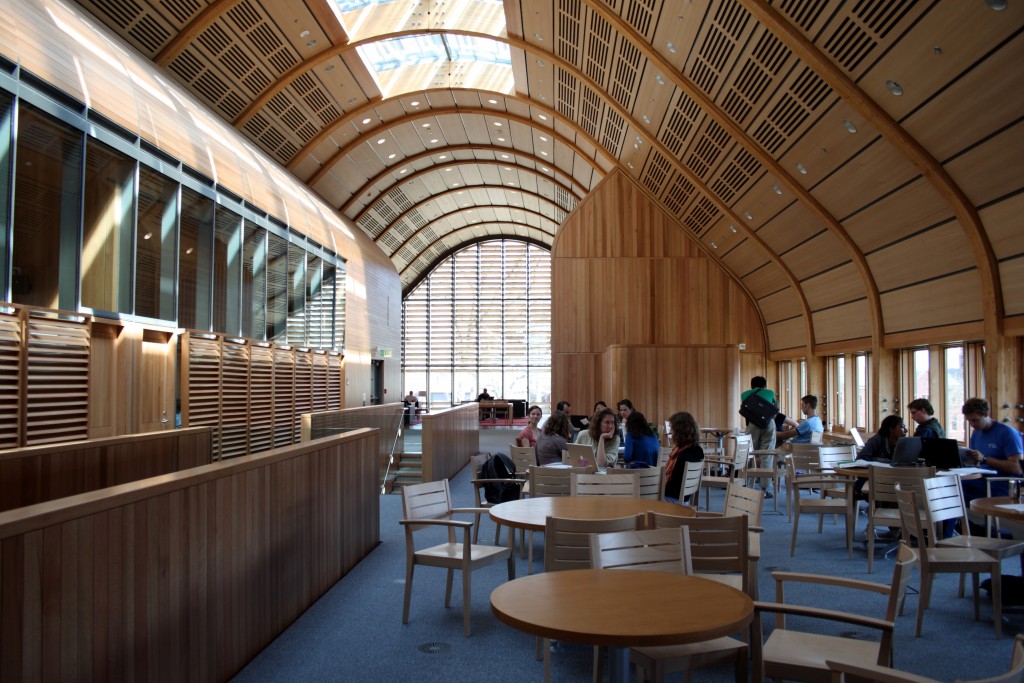As you enter a building, the surface of your skin collides with the building’s indoor air. Your skin senses the change and sends signals to the brain to adjust your internal metabolism. Your body works to achieve comfort: a dynamic balance between your internal temperature and the indoor air temperature. Ideally, a building should make it easier to achieve optimal comfort. In reality, buildings often make your body work harder, inducing shivers from a direct blast of air-conditioning, or sweat from stale, humid heat. The subtle interaction between skin and air is only one of many relationships a building forms with its users and natural environment. Green buildings in particular are designed with the natural environment in mind but all too frequently neglect the human occupant.
In the 1970’s, green architects and engineers sought to achieve energy efficiency in buildings at any cost. A major trend at the time was to use new technologies that saved energy by reducing air leaks in exterior walls. Misuse of this strategy caused health risks to occupants that went unnoticed until many people living in these new airtight homes became physically ill from poor indoor air quality. The industry’s focus on energy efficiency had created what became known as “sick building syndrome.” Designers treated the syndrome with technical solutions that improved indoor air quality but failed to address the underlying cause of the problem: industry had focused on the building’s relationship to the natural environment while ignoring the occupant’s relationship to the building. This social aspect of buildings went unaddressed into the 1990’s, when designers started to shift the focus of the green building movement towards a moneymaking strategy. The US Green Building Council (USGBC) webpage states, “Green building is a win-win, offering both environmental and economic opportunity.” This refocus, pairing economic and environmental concerns, again makes no mention of the needs of people. The building industry’s focus on money has not created a healthy and happy relationship with the users who will determine the ultimate success of the green building movement.
Building designers are the most influential and least affected people in a building’s life. They create the building’s form and function, then abandon it upon payment. Their relationship to the building is intensive and short. In contrast, the people that use the building are the most affected and least influential. They establish relationships with buildings that are longer lasting and frequently evolving. These two essential social groups in a building’s life, the design team and occupants, both play important roles in making a building green. The architect, for example, determines a building’s energy use by designing the windows, and the occupants determine a building’s energy use by opening and closing the windows. Unfortunately, these two groups rarely communicate or coordinate their efforts. This miscommunication often causes a breakdown between the designer’s intention and the occupant’s experience. Buildings unable to adapt to a major change from their designed form to their occupied use suffer from poor performance and damaged relationships among the building, its natural environment, and people.
* * *

Kroon Hall, Yale’s greenest and most energy efficient building, has been grappling with this very dilemma since its completion in 2009. When I started my master’s degree at Yale’s School of Forestry and Environmental Studies (F&ES), I heard occupants complain about their comfort in Kroon. Because I had arrived at the school after years of professional work in design and construction, I wanted to understand the occupant experience in a building internationally recognized for its sustainable design.
In 2015, I conducted a survey of all students, faculty, and staff at F&ES. The results of the survey show that Kroon succeeds mostly because of its pleasing visual aesthetics. On a scale of very dissatisfied (1) to very satisfied (5), Kroon’s aesthetics earned an average score of 4.7. The building’s naturally lit third floor and offices also helped Kroon achieve the top lighting satisfaction rating of all F&ES buildings with a score of 4.4.
The problems for Kroon arise when we leave the sense of sight. To the ear, Kroon is a distracting place. Complaints of offices that leak phone calls through their neighbor’s air vents and of stairwell conversations that travel through doors led to an average acoustic rating of 3.8. But the lowest rating of all was temperature. Kroon earned a 3.4 for average thermal comfort. Staff members, who spend the most time in the building, gave it a dissatisfaction rating of 2.4. “I do not deal well with humidity personally, and I find Kroon on a hot day in the summer to be unbearable,” said one respondent.
Problems occur not just in the summer; Kroon’s heating system has also struggled to keep up with the cold winters of New Haven, Connecticut. The designers were well-intentioned when they chose a heating system that tries to achieve comfort with the least amount of energy. An efficient heating system is a reasonable goal for a green building and one that was embraced by the building’s first occupants, some of whom told the design firm that they would willingly wear warm clothes in winter and cool clothes in summer. The missing variable in the designers’ calculations: occupants of the building constantly change. Subsequent generations of students and staff use the building in different ways and with different expectations. No designer can predict how a building will be used over its lifetime; buildings must be designed to allow occupants to adapt the building to their changing wants and needs.
In order to address these changing needs, I have been working with the F&ES administration over the past year on possible solutions to Kroon’s comfort issues. One response to the complaints about discomfort has been to raise and lower the temperature of the indoor air throughout Kroon. Air temperature does affect comfort but changing it takes a lot of energy, especially in a 53,000 square foot building. Additionally, adjusting the air temperature is a uniform change that occurs throughout the building. Yet according to the survey, only staff (who make up 10% percent of the building’s users) are unsatisfied with the comfort in their offices. An increase in air temperature thus fails to address the diversity of users. Comfort is a personal experience that should be controlled by personalized solutions.
Recently, I installed a thermal shade in the first floor office of a staffer who has felt cold. I wanted to demonstrate that it is possible — in an already highly energy efficient building — to increase comfort in a way that is personalized and does not increase energy. A thermal shade looks like any other shade except that it reduces the amount of heat that can move through it, keeping heat inside in the winter and outside in the summer. The shade is beige and translucent to let in light. The occupants can adjust the shade up or down when they feel warm or cold. Keeping the shade down at night, when the outdoor air is coldest, saves the heating system from working hard.


The most remarkable quality of this shade is that it addresses multiple variables that contribute to comfort. In addition to lowering the extremes of the indoor air temperature, the shade also lowers the temperature of the surfaces in the room and slows the flow of air. The temperature data collected for this experiment validated the effectiveness of this strategy, but the real determinant of success was that the staff kept the shade down all day and night. One occupant expressed that when she sat “right by the window, the shade was an excellent insulator.” She added, “I could feel the difference between having it up and down, particularly on cold days when the wind blew.” The shade works on the premise that occupants are a valuable part of the building system and that empowering them to create the conditions they desire will make them more satisfied.
If occupants are not seen as integral parts of a building, designers and builders will continue to lament that “the building was green until the occupants came along and messed it up.” The survey of Kroon Hall has taught me that buildings must be adaptable if they want to flourish alongside their occupants. Local and personalized controls like thermal curtains can also be accomplished with radiator valves, office thermostats, and desk fans. There is a fast turnover of users in most buildings, and achieving a satisfactory level of responsiveness to occupants requires coordination between the design and management teams. Buildings that are designed to be adaptively managed can co-evolve with the complex systems of occupants and natural environment. Only then can buildings improve in performance over their lifetimes and have the ability to benefit people as much as they benefit the planet. We, as building occupants, must demand the solutions that maximize both, as it is our personal experience that will become each building’s living legacy.